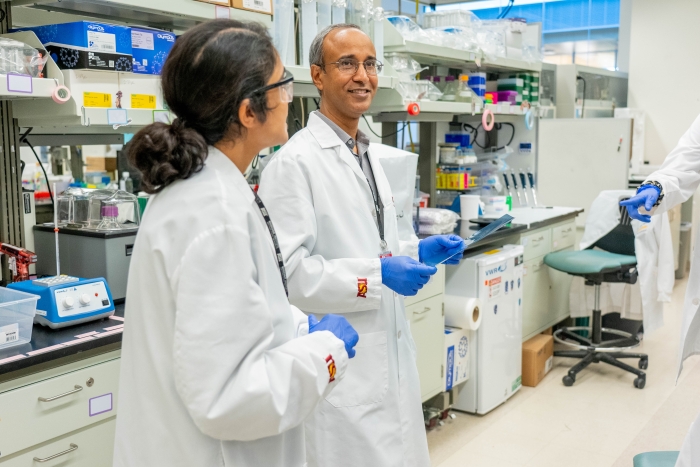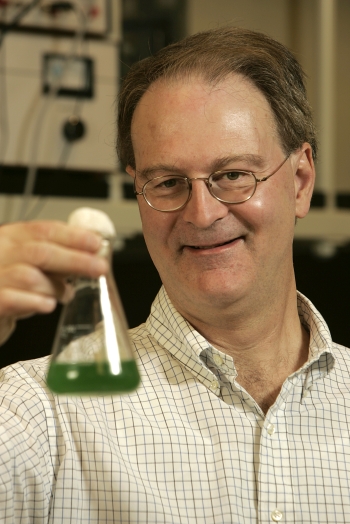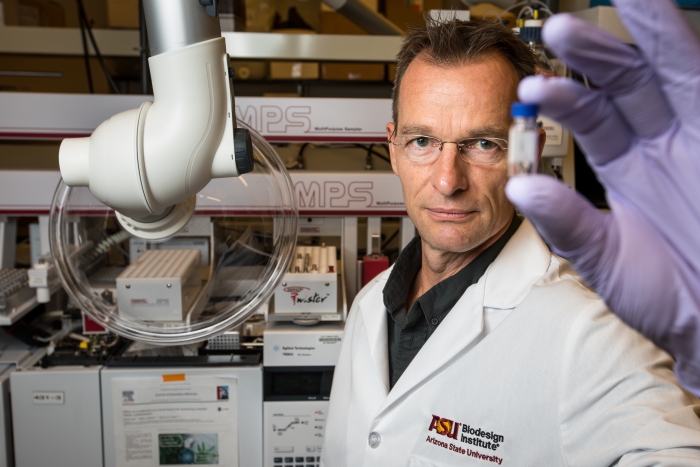'20 Years of Discovery' at ASU's Biodesign Institute: From cancer research to sustainable energy solutions

Graphic by Jason Drees/ASU
Editor’s note: The Biodesign Institute at Arizona State University is celebrating its landmark 20th anniversary. This is the second installment in a series called “20 Years of Discovery.” Each story reflects on several groundbreaking scientific discoveries and impactful innovations made since the institute was founded in 2004.
The Biodesign Institute plays a pivotal role in applying nature-inspired research and technological innovation to address some of the most pressing challenges of our time.
From pioneering cancer-fighting strategies and sustainable energy solutions to enhancing women's health through novel diagnostic and therapeutic approaches, the institute exemplifies a relentless pursuit of knowledge that not only deepens our understanding of the natural world but translates into tangible benefits for humanity.
Advancements in the multi-front battle against cancer
Cancer-fighting (oncolytic) viruses are an exciting new avenue in cancer research. Biodesign Institute scientists have focused efforts on fine-tuning such viruses, engineering them to aggressively attack cancer cells, without damage to normal tissue — a primary concern with conventional therapy.
The myxoma virus is an attractive candidate for such treatment. The virus is common and lethal in rabbits, but harmless to healthy human cells. Oncolytic viruses such as myxoma are used to selectively terminate malignant cells while augmenting the immune system's response to cancer. Scientists have proposed using an innovative approach involving a combination of oncolytic virotherapy and immunotherapy, a potential game changer for treatment-resistant cancers.
Further research demonstrates that when myxoma is combined with the anti-cancer drug Selinexor, myxoma’s oncolytic properties are enhanced, indicating another promising treatment strategy.
At the Biodesign Virginia G. Piper Center for Personalized Diagnostics, researchers have crafted a new way to detect early-stage pancreatic cancer using extracellular vesicles. These tiny bubbles of material emitted from cells act as biomarkers and could provide vital clues to diagnose pancreatic cancer and other illnesses. The research represents a crucial advance, given that current detection methods for pancreatic cancer are cumbersome, expensive and typically uncover the illness only at advanced stages.
ASU is also at the research vanguard in applying nanotechnology to cancer therapeutics, including the exploration of autonomous DNA nanorobots. Futuristic devices operating at the scale of billionths of a meter, these nanorobots are designed to seek and destroy tumors by cutting off their blood supply, essentially starving the tumor cells. This method represents a significant breakthrough in targeted cancer therapy and offers a high degree of precision.
“We are tackling challenges in cancer therapeutics and precision medicine with a unique angle, which is to develop smart nanobots that can be programmed to deliver drug payload to the exact location of the tumors and kill them,” says Hao Yan, director of the Biodesign Center for Molecular Design and Biomimetics.
ASU cancer researchers have investigated a crucial anti-cancer gene known as p53. Called the "guardian of the genome," p53 plays a pivotal role in cancer prevention. The gene’s primary function is to suppress tumors by regulating cell division and ensuring that cells with damaged DNA do not proliferate.
Researchers identified mutations in p53 associated with an aggressive form of breast cancer. In fact, mutations in the p53 gene are found in about half of all human cancers, making it a significant focus of cancer research.
Intriguingly, some large, long-lived animals have evolved additional copies of the p53 gene, which is thought to contribute to their surprisingly low rates of cancer. Elephants, for instance, have up to 20 copies of the p53 gene, providing them with enhanced ability to repair damaged DNA and eliminate potentially cancerous cells. This evolutionary adaptation showcases the importance of the p53 gene in cancer prevention and provides valuable insights for human cancer research and potential therapies.
Progress toward creating a clean energy alternative
The Biodesign Institute is also at the forefront of developing sustainable solutions to pressing environmental issues related to energy production. Researchers are investigating several innovations that span the use of biofuel-secreting microbes, microbial fuel cells, renewable bioproduction of fuels and chemicals, and the development of electrocatalysts — devices that improve the efficiency of chemical reactions — for cleaner energy solutions.
One of the most significant advancements involves the use of microbes to produce biofuel. ASU scientists are investigating the potential of algae and photosynthetic bacteria such as cyanobacteria to produce lipids, which can then be converted into renewable biofuels.
Cyanobacteria have shown the capacity to produce approximately 15,000 gallons of biofuel per acre, significantly outperforming plant or forest products such as corn or switchgrass. This is made possible because cyanobacteria have simple needs — nutrients, sunlight and CO2.
Extracting cellular ingredients for biofuels, however, is challenging both economically and environmentally due to toxic chemicals traditionally used in the process. The Biodesign Swette Center for Environmental Biotechnology has been exploring less harmful methods for lipid extraction, successfully testing several formulas that recover lipids with high efficiency.
The Biodesign Institute is making strides in other aspects of clean energy and environmental sustainability. By investigating the structure and function of proteins in plants and animals, which play crucial roles in converting energy from sunlight into oxygen and food, researchers hope their advances will help create a future for clean food and energy production.
A hybrid device merging the natural abilities of living organisms with a biobattery to generate sustainable power has been created, for instance. Called the microbial electro-photosynthetic system, it uses specially designed microbes, like genetically tweaked cyanobacteria. By giving these microscopic power plants a stream of external electrons, they can make a variety of useful products ranging from fuels for transportation to ingredients in beauty products.
Another avenue of discovery involves the creation of microbial fuel cells, devices able to convert leftovers and agricultural waste into electricity. These cells use bacteria to turn waste into power, which is not only efficient for generating energy but also an innovative way to handle waste. With the potential for integration into our cities and farms, such devices provide a dual benefit: reducing environmental degradation, and supplying green energy.
These cells could be integrated with municipal or agricultural waste streams for sustainable energy production and waste treatment. Researchers are working to understand and enhance the electron transfer processes in these devices, aiming to design systems that are both economical and efficient.
“Using novel electrochemical cells linked to microorganisms, we can generate new energy from the sun or recapture energy already embedded in organic waste streams,” says Bruce Rittmann, director of the Biodesign Swette Center for Environmental Biotechnology. “These are wonderful examples of environmental biotechnology, when we form partnerships with microorganisms able to provide services that make our human society more sustainable.”
Improving women’s health
The institute is advancing efforts to improve women's health, especially during pregnancy and childbirth. Studies show two-way traffic occurs between mother and fetal cells during pregnancy, influencing the mother's health for years after the birth of her child. Investigations of this phenomenon, known as microchimerism, provide insight into conditions including preeclampsia and multiple sclerosis.
Researchers are also examining how viral transformations in the female genital tract can negatively impact reproductive health. Certain viral infections increase risks for cervical cancer or infertility if left unchecked.
Biodesign scientists have tracked the exposure of pregnant women and fetuses to antibacterial compounds including triclosan and triclocarban, commonly found in everyday products. Studies suggest these compounds could lead to developmental and reproductive issues. Notably, triclosan was detected in all urine samples of pregnant women and in about half of umbilical cord blood samples, indicating fetal exposure.
This research underscores potential health risks associated with common antimicrobial products and contributes to the ongoing debate about their safety. Importantly, the research led to a groundbreaking decision by the FDA to ban the use of these products — a major success for the institute that positively impacts and improves human health nationwide.
Additionally, ASU scientists are investigating threats posed by chemicals found in everyday products like makeup, shampoos, and food packaging made from plastics. Exposure to some of these chemicals and polymers has been demonstrated in animal models to disrupt hormones, constituting a potential concern for pregnant women, the developing fetus, as well as children and adults of all ages. Pervasive chemicals including BPA have been linked to increased risks for breast cancer and endometriosis later in life. Thus, Biodesign Institute researchers are advocating for safer chemical policies to protect women.
Rolf Halden, director of the Biodesign Center for Environmental Health Engineering, notes that “the increased disease prevalence in the developed world of early onset puberty and colorectal cancer in young adults challenges environmental health professionals to identify and eliminate harmful environmental exposures, through a combination of smart policy solutions and safer chemical substitutions, to protect human health of this and future generations.”
Biodesign researchers also examined breast milk's antiviral and antibacterial properties in mothers with HIV. Some drugs, including antiretrovirals used to treat HIV, can pass through breast milk and impact infant health. Characterizing breast milk's natural benefits and pharmaceutical content aids treatment for afflicted women and their children.
Experts at the institute have also made vital discoveries enhancing the understanding of women's immune function. While women develop autoimmune diseases, including multiple sclerosis, lupus, and rheumatoid arthritis eight times more often than men do, their risk for nonreproductive cancers such as melanoma and colon, kidney and lung cancer are lower.
Researchers found that pregnancy expresses unique immune biomarkers that can leave mothers susceptible to some illnesses while safeguarding them from others. Studying the effects of pregnancy on immune function could improve health outcomes for women facing these illnesses later in life and offer insights into managing diseases during pregnancy.
'20 Years of Discovery' at ASU's Biodesign Institute
Explore the other installments in this series:
More Science and technology

Breakthrough copper alloy achieves unprecedented high-temperature performance
A team of researchers from Arizona State University, the U.S. Army Research Laboratory, Lehigh University and Louisiana State University has developed a groundbreaking high-temperature copper alloy…

4 ASU researchers named senior members of the National Academy of Inventors
The National Academy of Inventors recently named four Arizona State University researchers as senior members to the prestigious organization.Professor Qiang Chen and associate professors Matthew…

Transforming Arizona’s highways for a smoother drive
Imagine you’re driving down a smooth stretch of road. Your tires have firm traction. There are no potholes you need to swerve to avoid. Your suspension feels responsive. You’re relaxed and focused on…




